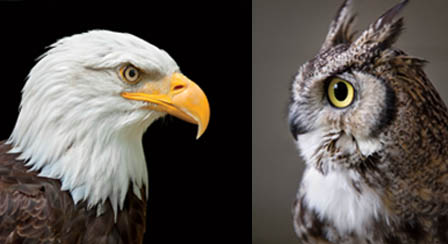
Audubon Adventures
Raptors: The Birds of Prey

Activities
 Activity 1
Activity 1
Raptors 24/7
 Teacher-led Classroom/Field Activity
Teacher-led Classroom/Field Activity
Science/Research Skills/Art/Writing
How are daytime-hunting and nighttime-hunting raptors similar and different?

Objective
Students use research skills to learn about raptor adaptations and to compare and contrast the adaptations of daytime (diurnal) raptors with nighttime (nocturnal) raptors.
Students will need:
- Paper and markers, crayons, paints, or colored pencils
- Reference books, field guides, and reliable websites
- Names of owl species written on slips of paper (repeats are fine)
- Names of diurnal raptor species written on slips of paper (repeats are fine)
Suggested time:
Two class periods, plus research time
What to do
- As a class, talk about adaptations. What is an adaptation? What are some examples of animal adaptations? What parts of a raptor’s body show how it’s adapted to the role of predator? What different challenges do daytime and nighttime raptors face?
- Divide the class into pairs. Have one member of each team draw a slip of paper from the “owls” pile. Have the other member draw a slip of paper from the “daytime raptors” pile, so that each pair has the name of one owl and one daytime-hunting raptor.
- Explain to the class that each pair will profile its owl and its daytime raptor. Basics to include are what the raptor eats, its habitat, and the role it plays in the ecosystem. Each team will also point out how each raptor is adapted to its habitat and uses its adaptations to help it catch prey. They will also compare and contrast the two birds to show how a daytime raptor and a nighttime raptor have adaptations that enable them to hunt in different levels of light. How might this help both raptors get enough to eat?
- Guide students to work together to conduct research, organize their information, and then create posters about each bird, presenting what they’ve learned and answering the research topics described in #3 above. Ideally, the posters will feature an image of each raptor with its adaptations pointed out. Students can then present their raptor studies to the class.
Photos: Jim Verhagen; Andyworks/iStockphoto; Luke Franke/Audubon




